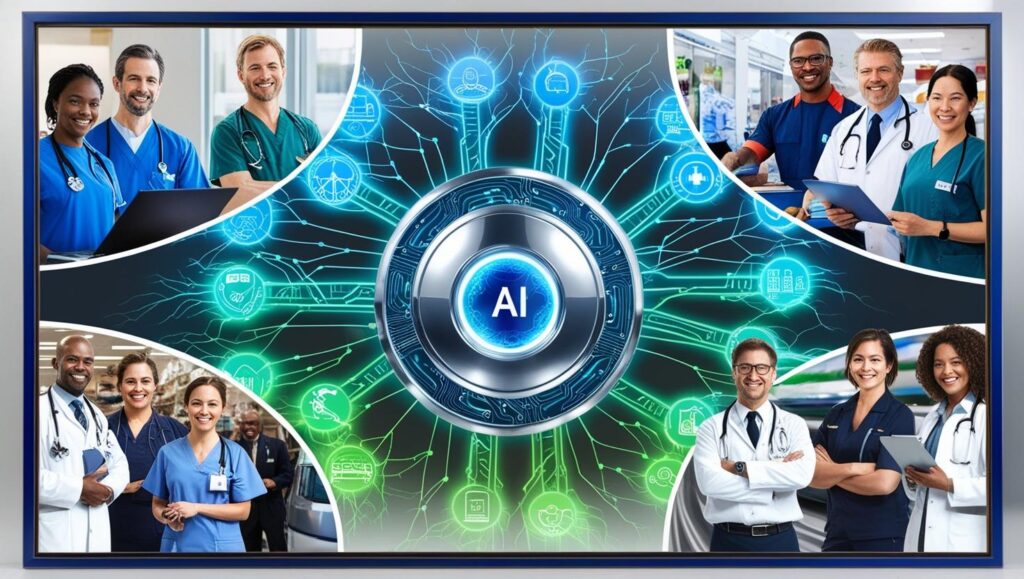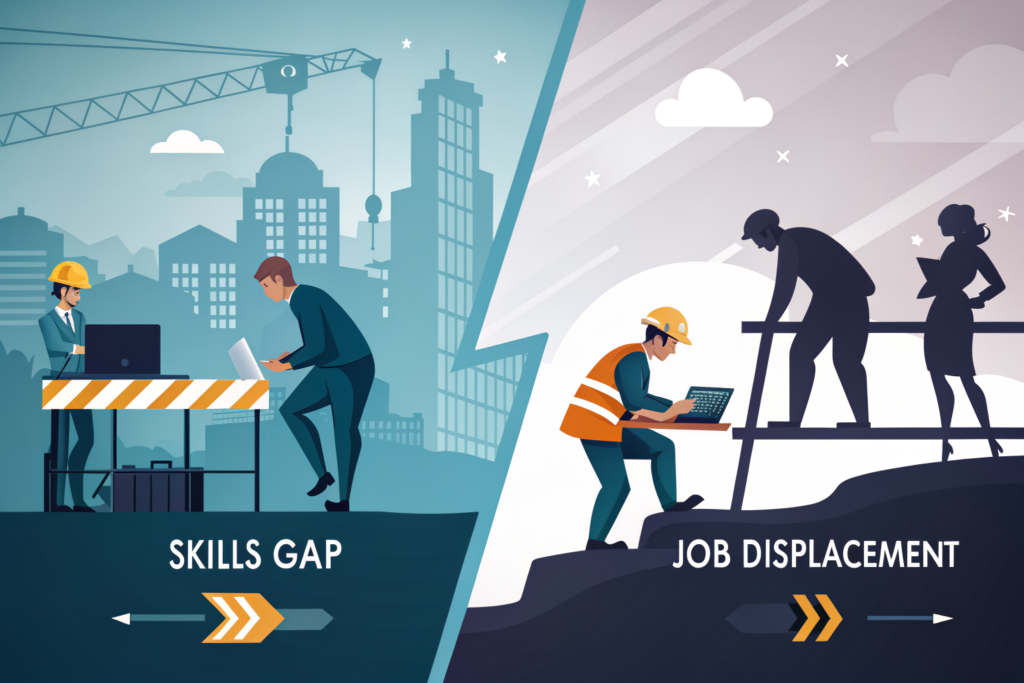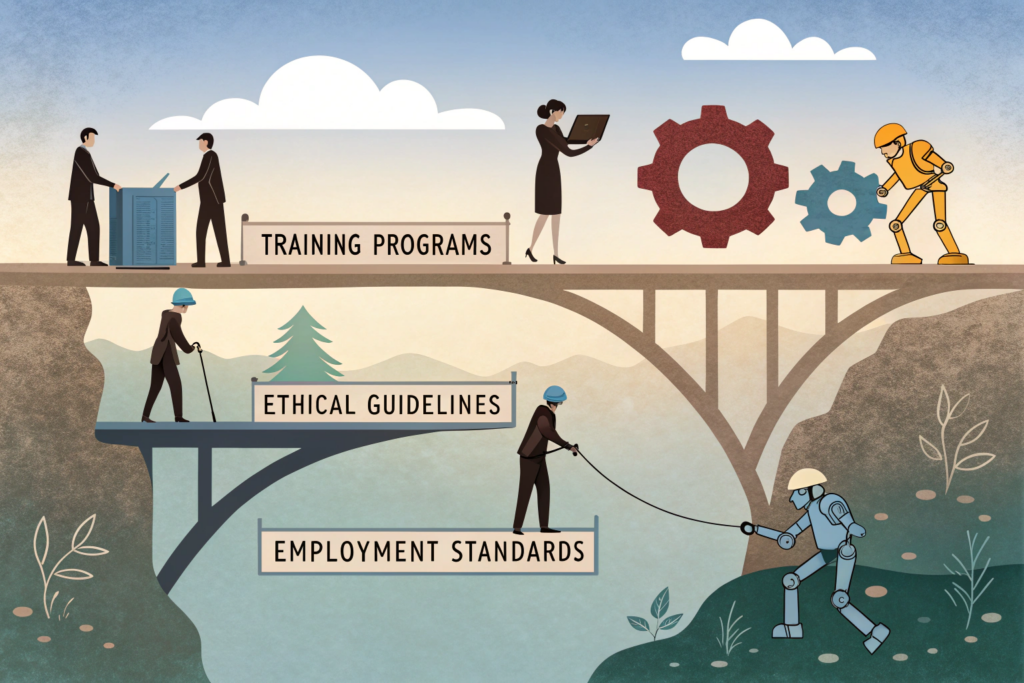
Artificial Intelligence (AI) is revolutionizing industries by augmenting human workers’ critical thinking, decision-making, language processing, and pattern recognition capabilities. This transformative technology reshapes various sectors and the workforce, enhancing operational efficiencies and fostering innovation.
Recent data reveals a significant increase in AI adoption, with 72% of organizations integrating AI into at least one business function by 2024. Monthly reports indicate that this rapid adoption introduces new job opportunities and challenges, profoundly impacting employment rates.
Furthermore, as AI becomes more embedded across business operations, similar to how automation shaped industries in the past, its role is expected to ripple across sectors like healthcare, transportation, and retail, creating significant labor market shifts throughout the year.

Employment Challenges and Potential Risks
While AI creates opportunities for highly skilled roles, it poses potential risks, particularly for employees engaged in manual jobs and those lacking advanced education. Technology widens the gap in the labor market between high- and low-skilled workers, with less-educated employees facing higher displacement risks and increased unemployment rates.
Adopting AI demands adaptability and new skills from the workforce, raising concerns about ethics, transparency, and trust in AI-driven decision-making processes. Additionally, market disruptions driven by AI adoption may exacerbate economic inequalities as wage growth benefits higher-educated professions while stagnating in roles requiring fewer specialized skills.
Industries like healthcare and transportation may share common grounds by advocating policies and training programs that simultaneously address labor shortages and displacement concerns, fostering equitable employment growth.
The Role of Governments and Employers
Governments are proactively navigating these changes to maximize AI’s benefits while mitigating its adverse effects on employment. National strategies, such as Canada’s National AI Strategy and the US’s American AI Initiative, aim to boost AI usage, attract international investment, and develop technology talent. Employers, too, play a crucial role by acting as high-road employers.
In a pre-regulatory moment, voluntary actions can establish standards for AI deployment, involving human workers in designing AI integration and focusing on complex tasks that enhance job quality.
Furthermore, through workforce development programs administered by community boards and government associations, businesses can help alleviate unemployment risks, reaffirming their commitment to fair labor practices and inclusive growth strategies.
Monthly surveys and annual reports highlight the effectiveness of these programs in reducing unemployment rates and increasing job openings across various sectors.

The Impact of AI on the Job Market
Artificial Intelligence (AI) is increasingly influencing various sectors, bringing about significant changes in the job market. As AI technology evolves, it creates new opportunities and challenges traditional employment structures, necessitating a shift in workforce dynamics and skill sets.
Market uncertainties also accompany the rise of AI adoption, as industries seek to balance technological integration with increased demand for transparency and ethical guidance on labor policies.
Monthly data reviews and annual surveys indicate that AI will continue to shape the economic landscape, influencing employment rates and job growth across different industries throughout the year.
The Rise of Automation and New Job Opportunities
AI-driven automation streamlines operations across industries, from manufacturing to healthcare, leading to increased efficiency and productivity. This transformation allows organizations to reallocate resources towards innovation and growth, ultimately creating new jobs.
These emerging opportunities are particularly prominent in fields related to STEM (Science, Technology, Engineering, and Mathematics) and IT. As companies integrate AI systems, there is an increasing demand for employees with robotics, engineering, and considerable data analysis expertise.
Consequently, the workforce is transitioning towards a more educated and technically skilled demographic, highlighting the growing importance of technical knowledge in the modern job market.
Some industries have recognized AI’s potential to directly solve chronic underemployment issues, ensuring alignment between talent pipeline initiatives, training programs, and national labor policies. Monthly reports show a steady increase in job openings and career growth opportunities in these sectors throughout the year.

The Divide Between High-Skilled and Low-Skilled
Despite AI’s positive prospects, it also poses significant challenges, particularly for workers involved in manual tasks or lacking advanced education. AI technologies often exacerbate the divide between high-skilled and low- skilled workers, placing less-educated employees at a higher risk of job displacement and reduced income.
The rapid adoption of AI requires employees to be adaptable and ready to embrace new roles, raising concerns about ethics, transparency, and trust in AI-driven decisions.
Moreover, displaced workers could face barriers to reemployment if offered retraining programs that don’t align closely with evolving market needs, potentially perpetuating job insecurity over the long term.
Monthly unemployment reports and annual labor market reviews emphasize the need for targeted training and education programs to mitigate these risks and support workforce resilience.
The Responsibility for Adverse Effects
In response to these challenges, governments and employers are taking proactive measures to maximize AI’s benefits while mitigating its adverse effects on employment. National strategies, such as Canada’s National AI Strategy and the US’s American AI Initiative, aim to foster AI adoption, attract global investment, and cultivate a skilled technology workforce.
Employers also have a crucial responsibility to shape the future of work by voluntarily establishing standards for AI deployment. By involving human workers in designing AI integration and focusing on complex tasks that enhance job quality, employers can help smooth the transition and ensure that AI augments rather than replaces human labor.
Local workforce boards have emerged as pivotal intermediaries, connecting job seekers directly with AI-related employment opportunities, fostering collaboration between training providers, businesses, and policymakers. Monthly surveys and annual reports track the effectiveness of these initiatives in reducing unemployment and increasing job openings across various sectors.

Harnessing AI Potential
In conclusion, AI is reshaping the labor market, generating new opportunities and intensifying competition for specialized skills. While AI offers substantial productivity gains, it also brings challenges related to workforce adaptability and ethical considerations.
Policymakers and employers must collaborate to harness AI’s potential while addressing the risks posed to human workers, particularly those in manual roles. By balancing innovation with workforce development, including ongoing education and training programs, society can ensure the advent of AI benefits everyone.
Targeted efforts such as continuing education programs and incentives for employers hiring AI-skilled workers can actively contribute to smoother market transitions, economic growth, and equitable workforce outcomes throughout the year.
FAQ
How do I stay informed about the current job market trends and forecasts?
To stay informed about job market trends and forecasts, follow organizations like the World Economic Forum, which publish reports like the Future of Jobs Report, and consult labor market news from sources like SHRM and Velocity Global, which provide insights into trends and projections.
What factors influence job growth in specific industries?
Factors influencing job growth in specific sectors include technological advancements, demographic shifts, economic conditions like GDP and inflation rates, and policy changes (e.g., clean energy investments).
How do I tailor my skills to match the most in-demand jobs in the market?
To tailor skills for in-demand jobs, focus on developing technological expertise, particularly in AI and big data, along with human-centric skills like resilience and leadership. Engage in continuous learning through courses and certifications relevant to emerging fields, such as renewable energy and healthcare, to enhance employability.
What sources are reliable for finding job market projections and employment data?
Reliable sources for job market projections and employment data include the Bureau of Labor Statistics (BLS), especially the Occupational Outlook Handbook, and analyses from organizations like Indeed and Georgetown University’s Center on Education and the Workforce.

